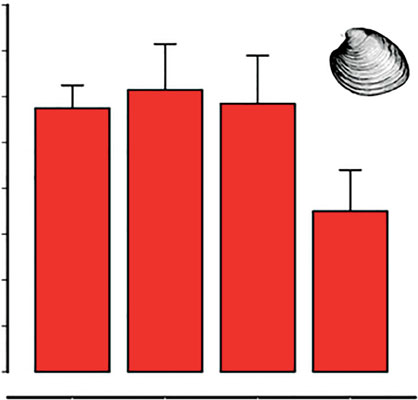Conditions resulting in low dissolved oxygen (DO) in marine systems, also known as hypoxia, are a commonoccurrenceinoceans around the world. Ocean acidification(OA), which results in lower pH, is a newer phenomenon, but often co-occurs with hypoxia due to elevated water temperatures and accelerated nutrient delivery from land. A new review of the effects of hypoxia and OA on marine animals shows that effects of these conditions are complex and unpredictable; vary among species and life stage; and depend upon whether hypoxia or low pH occur alone or in tandem. Results show that hypoxia and OA can affect organism survival and growth.

Published in The Royal Society Biology Letters, scientists supported by NCCOS and the NOAA Ocean Acidification Program reviewed prior experiments regarding the effects of hypoxia and ocean acidification on a variety of marine mollusks and fish, both singly and in combination. Very few studies have actually assessed the extent to which the combination of both stressors affect marine organism growth, reproduction and productivity. However, some general findings and highlights from the review are:
- Hypoxia alone is a greater short-term stressor to most organisms than acidification; acidification is usually amore persistent and longer-term (weeks, months, years) condition than hypoxia (hours, days, weeks).
- The addition of low pH (acidification) to low dissolved oxygen (hypoxia) has worse effects than hypoxia alone and the combined stressors bring more extreme outcomes than from the sum of individual effects.
- Hypoxia and OA can make organisms more vulnerable to other toxins, diseases, and parasites.
- DO management criteria in coastal waters have been developed without consideration of pH levels. Given the persistence of concurrent low pH, low DO conditions in estuaries, and the increased mortality experienced by fish and bivalves under concurrent acidification and hypoxia, such DO criteria may leave coastal fisheries more vulnerable than previously anticipated.
The authors recommend: (1) expanding multi-stressor experimental, field, and modelling studies; (2) raising regulatory DO standards to higher minimums to account for low pH synergistic effects; and (3) reducing nutrient loads and acidification sources coupled with careful monitoring of pH, dissolved CO2, and carbonate chemistry (acid buffering) in coastal zones. These actions are important for better understanding and mitigation of the threat of acidification to marine life and for setting regulatory limits for DO and pH that protect valuable marine resources.
For more information, contact Elizabeth Turner.
